 |
BusTalk
A Community Discussing Buses and Bus Operations Worldwide!
|
| View previous topic :: View next topic |
| Author |
Message |
Mr. Linsky
BusTalk's Offical Welcoming Committee

Joined: 16 Apr 2007
Posts: 5071
Location: BRENTWOOD, CA. - WOODMERE, N.Y.
|
 Posted: Mon Oct 29, 2007 3:53 pm Post subject: Posted: Mon Oct 29, 2007 3:53 pm Post subject: |
 |
|
Pictured below in a factory photo is fleet # 62 – a 1941 Mack Model RB3G and one of three (ser#’s 1069 to 1071) operating for Boro Buses Corporation of Red Bank, New Jersey and delivered in December of that year.
The RB series, considered a medium duty 29 seat (27 with rear door) bus and Mack’s answer to the popular Ford Transit of the same capacity, was introduced in 1941 with a 354 cu. Inch, 116 horsepower engine and a short wheelbase measuring 158 inches.
These coaches were very useful and became the backbones of many small fleets with a total of 172 being sold in only two years of production before the war.
Boro purchased and additional three RB’s which were among the last to be delivered in July of 1942.
Of particular note on the pictured model are the optional fog lights which seem to be prevalent on most buses operating in New Jersey.
Photo courtesy of NYC Subway site.
Mr. Linsky – Green Bus Lines, Jamaica, NY
3992
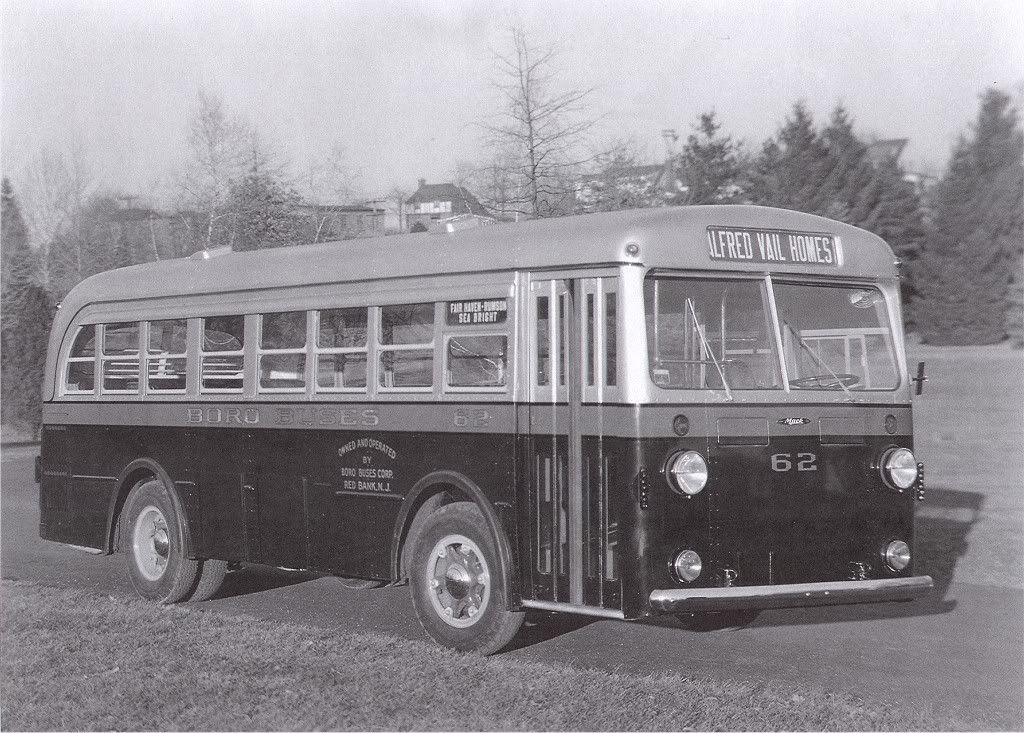 |
|
| Back to top |
|
 |
Mr. Linsky
BusTalk's Offical Welcoming Committee

Joined: 16 Apr 2007
Posts: 5071
Location: BRENTWOOD, CA. - WOODMERE, N.Y.
|
 Posted: Tue Oct 30, 2007 12:47 pm Post subject: Posted: Tue Oct 30, 2007 12:47 pm Post subject: |
 |
|
A brief history of Boro Buses Corporation of Red Bank New Jersey featured above (as reported in Motor Coach Age);
In March of 1984 the company, a local operator in Monmouth County, New Jersey, ended transit operations but continued charters and Atlantic City casino runs.
Formed in 1921 to succeed the Monmouth County Electric Railway Company which ran two routes between Long Branch and Red Bank, Boro expanded through the years with the acquisition of routes centered in Red Bank that had been previously owned by smaller companies and individuals.
As did so many other independent operators, Boro joined New Jersey's subsidy program in July of 1971 and continued operation until March of 1984 when both its routes and state-owned buses were transferred to Monmouth Bus Lines.
Monmouth Bus Lines itself became part of New Jersey Transit in mid 1989.
Mr. Linsky - Green Bus Lines, Jamaica, NY |
|
| Back to top |
|
 |
Mr. Linsky
BusTalk's Offical Welcoming Committee

Joined: 16 Apr 2007
Posts: 5071
Location: BRENTWOOD, CA. - WOODMERE, N.Y.
|
 Posted: Tue Oct 30, 2007 8:04 pm Post subject: Posted: Tue Oct 30, 2007 8:04 pm Post subject: |
 |
|
Pictured below in a factory photo is fleet # 70 – a 1948 Mack Model C-33-DT (Diesel Transit) operating for Pierro & Sons, Inc. (DBA Central Avenue Transit Lines) of Jersey City, New Jersey and delivered as a one bus order in September of that year.
Introduced in 1948, the C-33 (33 passenger 180 inch wheelbase) Mack was to target the already successful GM TDH 3200’s but shared the manufacturer’s reputation for being too heavy and thirsty for both fuel and lubricating oil.
This deficiency in operating economics lead to widespread cancellations of orders even from devoted prewar Mack customers.
Consequently, a total of only 59 C-33’s were built between 1948 and 1950 of which 9 were Diesels.
In the early to mid 1920’s New Jersey held the crown being the ‘bus capital’ of the world with hundreds upon hundreds of independent operators taking to the highways of virtually every town and city in the state competing against both what was left of street railways and the then fledgling Public Service Coordinated Transport.
Despite all odds, and in contrast to their New York contemporaries, they ran successfully for many years and created their own niche in the history of surface transportation - Pierro & Sons of Jersey City were among those entrepreneurs.
Photo courtesy of NYC Subway website.
Mr. Linsky – Green Bus Lines, Jamaica, NY
4168
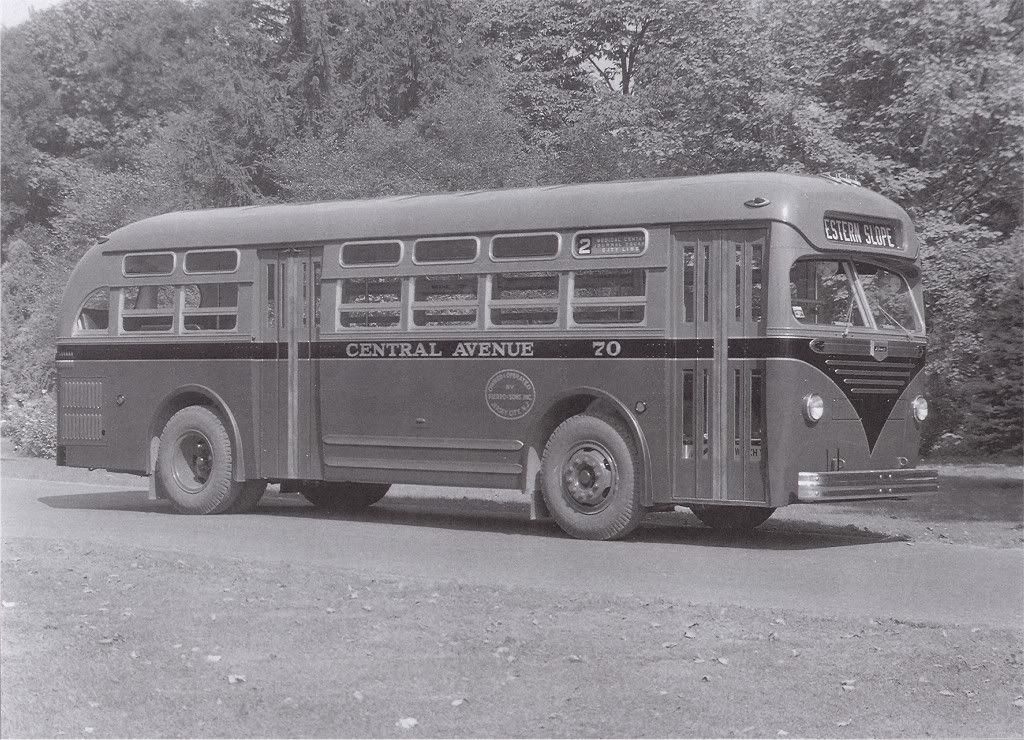
Last edited by Mr. Linsky on Wed Oct 31, 2007 12:35 am; edited 1 time in total |
|
| Back to top |
|
 |
Mr. Linsky
BusTalk's Offical Welcoming Committee

Joined: 16 Apr 2007
Posts: 5071
Location: BRENTWOOD, CA. - WOODMERE, N.Y.
|
 Posted: Tue Oct 30, 2007 11:40 pm Post subject: Posted: Tue Oct 30, 2007 11:40 pm Post subject: |
 |
|
Jokingly, but in a loving way, I always tease Bob (Q65A) by calling his favorite PBL 'The Orange Buses', never realizing that that is exactly what Queens/Nassau Transit called themselves as noted in the slogan under the drivers window in the ACF shot below.
I have also attached a couple of interesting ACF ads from 1937 which depict the ease of repair of these coaches and the famous Hall Scott pancake amidships engine that powered them.
Photo from NYC Subway site gallery.
Enjoy.
Mr. Linsky - Green Bus Lines, Jamaica, NY
4191
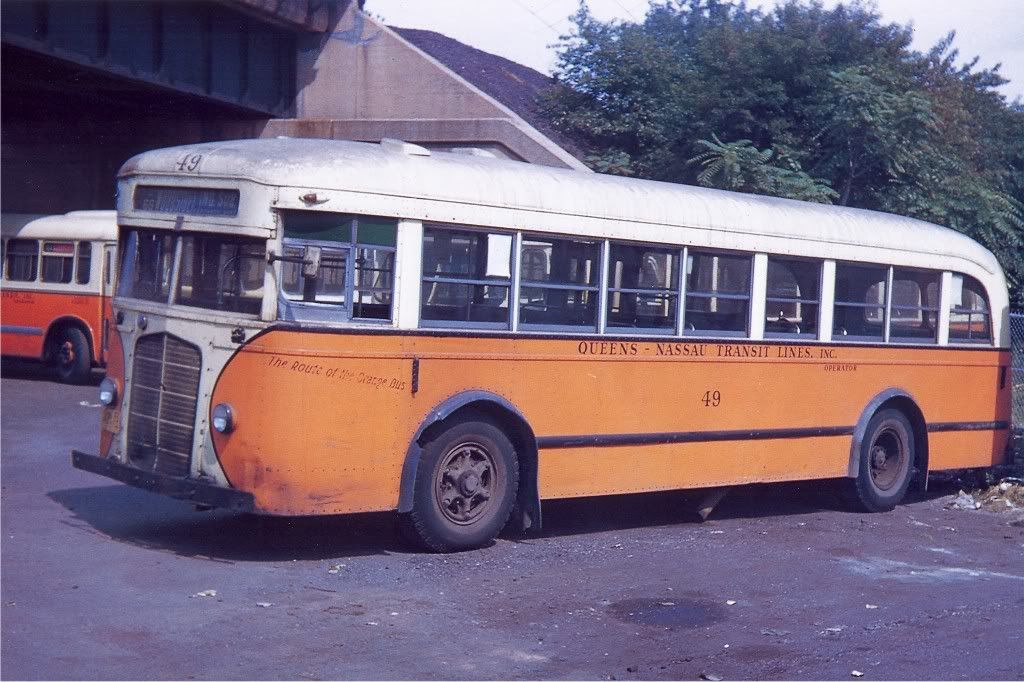

 |
|
| Back to top |
|
 |
Mr. Linsky
BusTalk's Offical Welcoming Committee

Joined: 16 Apr 2007
Posts: 5071
Location: BRENTWOOD, CA. - WOODMERE, N.Y.
|
 Posted: Wed Oct 31, 2007 7:22 pm Post subject: Posted: Wed Oct 31, 2007 7:22 pm Post subject: |
 |
|
Pictured below is a factory photo of fleet # 201 – a 1933 Twin Coach Model ‘40’ and delivered to Jamaica Buses of Baisley Park, New York in the spring of that year.
The 39 passenger # 201 is believed to be among the very first new buses for the company that were required to meet their franchise agreement to convert four routes of the Jamaica Central Railway Company in both Queens and Nassau counties in 1933.
Introduced in 1927, the Twin Model ‘40’ was unique in many respects in that it was designed to look much like a trolley car (awaiting passengers had a difficult time discerning which way the bus was heading from a distance), and it was powered by twin Hercules engines mounted under floor amidships (a revolutionary idea at the time).
Both Mack and ACF imitated the design but neither had Twin’s success in selling well over one thousand units between 1927 and 1937.
Also seen below (lower) is fleet # 1001 – the trolley bus version of the Model ‘40’ operating for the Brooklyn and Queens Transit Corporation and signed for Flatbush Avenue.
The B&QT was an off shoot of the Brooklyn Bus Corporation created in 1929 as a feeder to street cars lines throughout the borough and equipped the subsidiary with 225 new buses in 1931 of which 175 were Twin Model 40's.
A personal note; as a camper in Rockaway at the Ostend baths in the late 40’s, which was the southern terminus for Jamaica’s Far Rockaway route, I used to be enthralled by the Twin 40’s on layover with their bright red and cream Jamaica livery.
Photo credit to NYC Subway website.
Mr. Linsky – Green Bus Lines, Jamaica, NY
4337

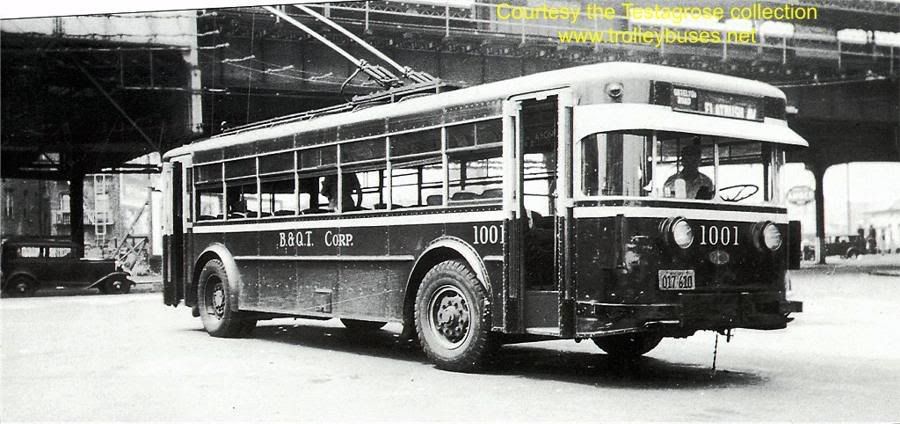 |
|
| Back to top |
|
 |
Mr. Linsky
BusTalk's Offical Welcoming Committee

Joined: 16 Apr 2007
Posts: 5071
Location: BRENTWOOD, CA. - WOODMERE, N.Y.
|
 Posted: Thu Nov 01, 2007 11:07 pm Post subject: Posted: Thu Nov 01, 2007 11:07 pm Post subject: |
 |
|
Bob S.,
"This Bud's for you!" - Enjoy;
Pictured below is a factory fresh photo of fleet # 2000 - a 1939 Mack Model CW3G (ser# 1122) and one of 20 (#2000 to 2019) delivererd to the Steinway Omnibus Corporation of Queens, New York in September of that year.
Earlier in this forum (page 4) I touched upon the attributes of the Mack Model CW with its versatility and its ability to service low traffic routes so I won't bore you with further details here!
I'm only sorry that the photo is not in color because I have an idea that the paint scheme must have been very interesting.
Photo courtesy of and with many thanks to The Mack Truck Museum of Allentown, Pa.
Mr. Linsky - Green Bus Lines, Jamaica, NY
4492
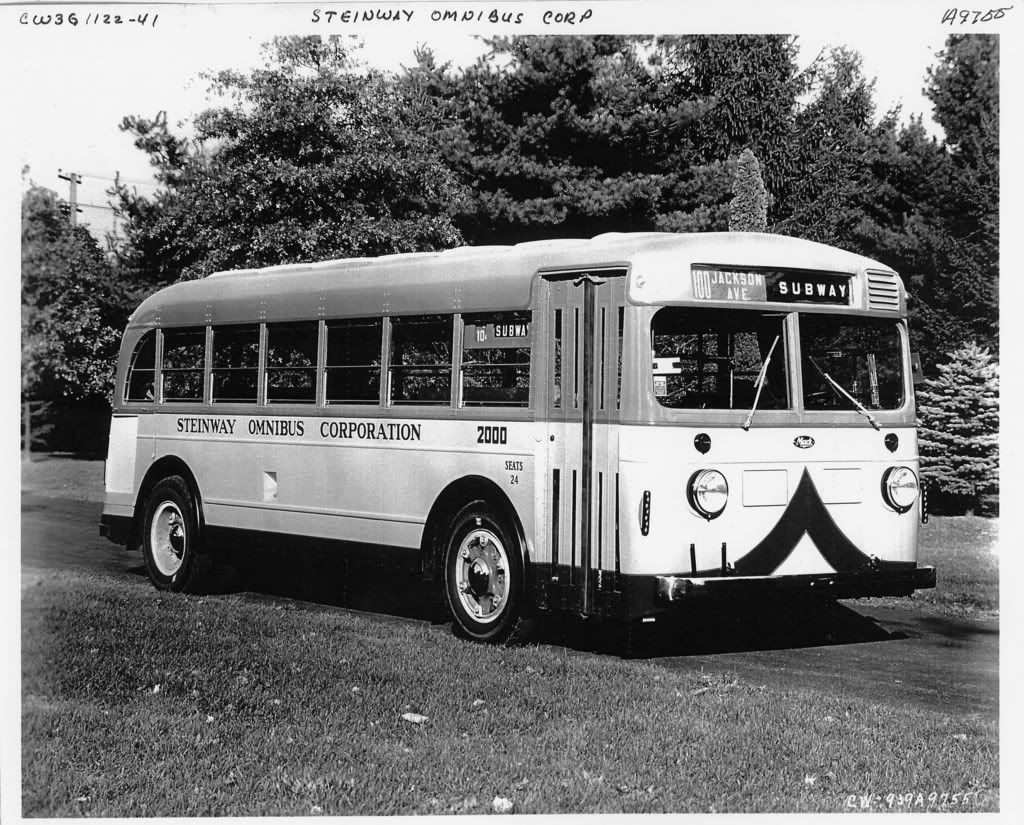
Last edited by Mr. Linsky on Fri Nov 02, 2007 1:03 am; edited 1 time in total |
|
| Back to top |
|
 |
Mr. Linsky
BusTalk's Offical Welcoming Committee

Joined: 16 Apr 2007
Posts: 5071
Location: BRENTWOOD, CA. - WOODMERE, N.Y.
|
 Posted: Fri Nov 02, 2007 12:58 am Post subject: Posted: Fri Nov 02, 2007 12:58 am Post subject: |
 |
|
Pictured below, in a factory photo sans a fleet number and an operator’s name, is a Mack Model LD3G (ser# 1016) and one of 34 such coaches delivered to The Connecticut Company between June 1941 and November 1942.
The ‘LD’ series of Macks, with seating for 35 passengers, were considered to be in their heavy duty class with a wheelbase of 218 inches, a unitized body and a large 510 cubic inch 150 hp engine needed to push its 15,200 pounds plus a full load. 371 LD's were manufactured between 1941 and 1943.
The Connecticut Company (a subsidiary of the New York New Haven and Hartford Rail Road) had its beginnings in 1920 as an operator of street cars lines until conversion to buses began in 1936.
Connecticut’s buses, along with the stock of its sister company the Berkshire Street Railway of Pittsfield, Mass., came in a very bland and austere dark blue under the window belt and battleship gray the rest of the way, and lettering was a simple ‘Connecticut’ and ‘Berkshire' (for Pittsfield).
It would appear as though the company did its own lettering and numbering because the buses left the factory incognito as can be seen in the picture (in fact, the historian who found the photo at Mack would not have known who the bus was made for without the hand written notes at the top!).
Mr. Linsky – Green Bus Lines, Jamaica, NY
4521
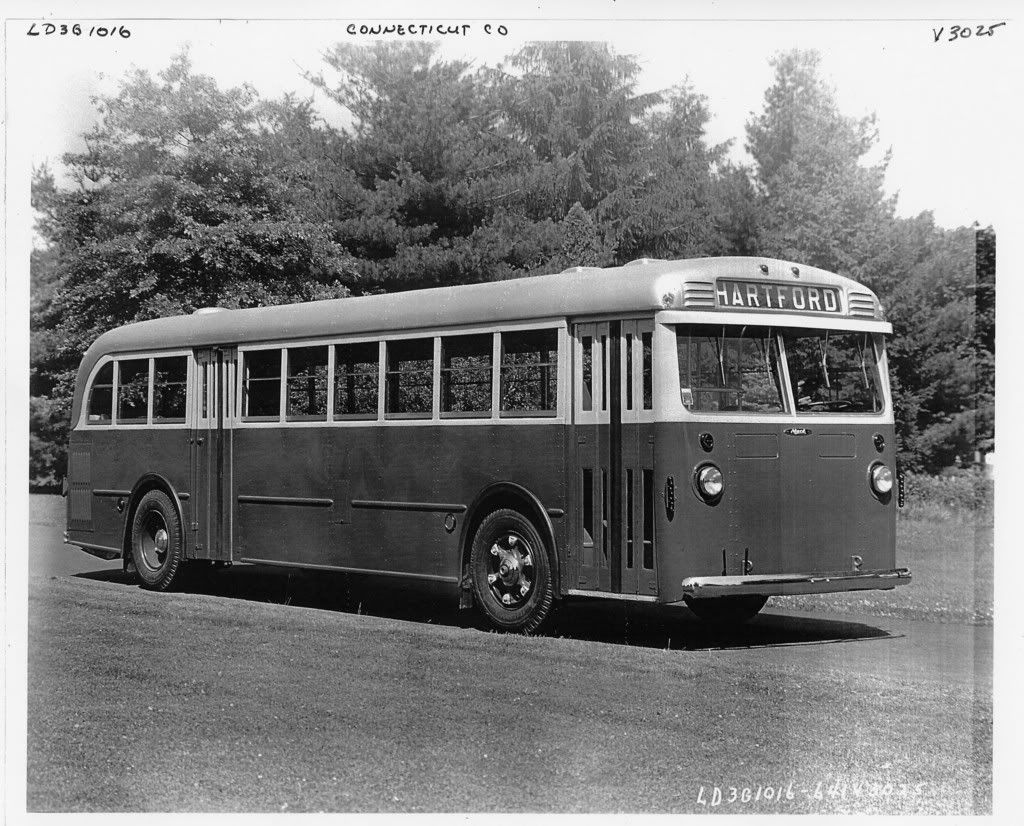 |
|
| Back to top |
|
 |
Q65A
Age: 66
Joined: 17 Apr 2007
Posts: 1768
Location: Central NJ
|
 Posted: Fri Nov 02, 2007 7:56 pm Post subject: Posted: Fri Nov 02, 2007 7:56 pm Post subject: |
 |
|
Thanks very much for these great shots, Mr. L! 
You certainly know that I do have a soft spot in my heart for Queens Transit and Queens Surface; as I sit at the keyboard typing this message, I'm wearing a cap bearing a QSC patch (given to me by my late buddy, Hawk Operator 10, may God rest his soul.)
When I was growing up in Electchester, the folks in my neighborhood always called Queens Transit buses "the orange buses", as their livery at that time was orange & cream. We called the NYCTA buses running on the Q17, Q44, and Q44A (today's Q46) "the green buses", as their livery at the time was dark green (plus a light green roof on the GM Old Looks).
When the Q65A (today's Q64) would terminate at 108th St. & 71 Ave. in Forest Hills, we also would refer to the Q60 as the Green bus (as in GBL).
When you live in NYC's outer boroughs, you have to know the buses as well as the subways if you need to get around car-free (and on time, too, in the rush hours.) |
|
| Back to top |
|
 |
Mr. Linsky
BusTalk's Offical Welcoming Committee

Joined: 16 Apr 2007
Posts: 5071
Location: BRENTWOOD, CA. - WOODMERE, N.Y.
|
 Posted: Fri Nov 02, 2007 10:18 pm Post subject: Posted: Fri Nov 02, 2007 10:18 pm Post subject: |
 |
|
Bob,
Funny that you should mention the dark green buses of the Board of Transportation because it was that dark green and silver combination that too closely resembled Green Bus Line's original livery, and it was for that reason that GBL's livery was changed to apple green and cream in 1948.
My memories of Queens Nassau Transit (back when) are limited as their routes were generally out of my purview.
I do remember them coming down to Parsons Boulevard and Hillside Avenue - but my best memory was of the Q65A (cxoincidence) layovers at the Ridgewood Savings Bank (where I opened my first bank account) on Queens Boulevard and 108th. Street (that intersection was heavy with Green Line, Triboro, the Orange Buses and an occasional fast moving Carey Airporter - fascinating to watch!).
The picture below sets the scene - all you have to do is replace the RTS with a sparkling brightly colored Q/N TDH 5104 (circa 1952) in your mind and you have read mine!
Photo taken by Michael Pompili and borrowed from BTIII gallery for educational purposes only.
BTW; thanks for the accolades - they are greatly appreciated!
Mr. Linsky - Green Bus Lines, Jamaica, NY
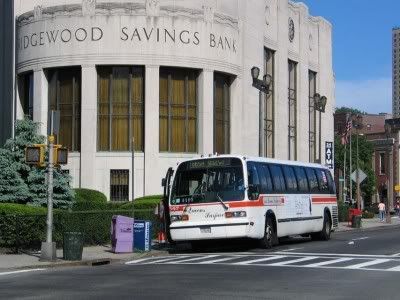 |
|
| Back to top |
|
 |
Mr. Linsky
BusTalk's Offical Welcoming Committee

Joined: 16 Apr 2007
Posts: 5071
Location: BRENTWOOD, CA. - WOODMERE, N.Y.
|
 Posted: Fri Nov 02, 2007 11:33 pm Post subject: Posted: Fri Nov 02, 2007 11:33 pm Post subject: |
 |
|
Pictured below (upper) is a factory photo of fleet # 909 – a 1937 Mack Model 6CQ3S and one of 48 such buses (ser# 1553 to 1592 and 1663 to 1672) that were delivered to CR&L Lines (Connecticut Railway and Lighting Company) between February and September of 1937.
First introduced in 1935 and in a much more squared ‘CX’ type body style, the 31 passenger Mack CQ was revised in the smoother and more rounded lines as pictured for reintroduction in 1937, and very closely resembled the popular larger capacity model ‘CT’.
However, and unlike its underpowered big brother, the CQ was no slowpoke with a 468 cu. in., 118 horsepower six cylinder engine and a three speed single reduction transmission.
882 CQ’s were manufactured in three variations between 1934 and 1939.
Also pictured below, in a rare factory shot, is the interior of # 909 exhibiting the genuine quality of all prewar Mack buses.
CR&L equipped all their coaches with standard hot water under seat heating systems as well as optional electric units as can be seen over the rear door and at the dashboard.
Also of interest is the ‘shower curtain’ type divider behind the driver for night time glare reduction.
I personally remember these buses on my sojourns through western Connecticut years ago and they were very pleasant looking in their light green, cream and silver liveries.
The CQ’s enjoyed a good reputation among operators throughout the country and served well for many years.
Photos courtesy of the Mack Truck Museum of Allentown, Pa.
Mr. Linsky – Green Bus Lines, Jamaica, NY
4650

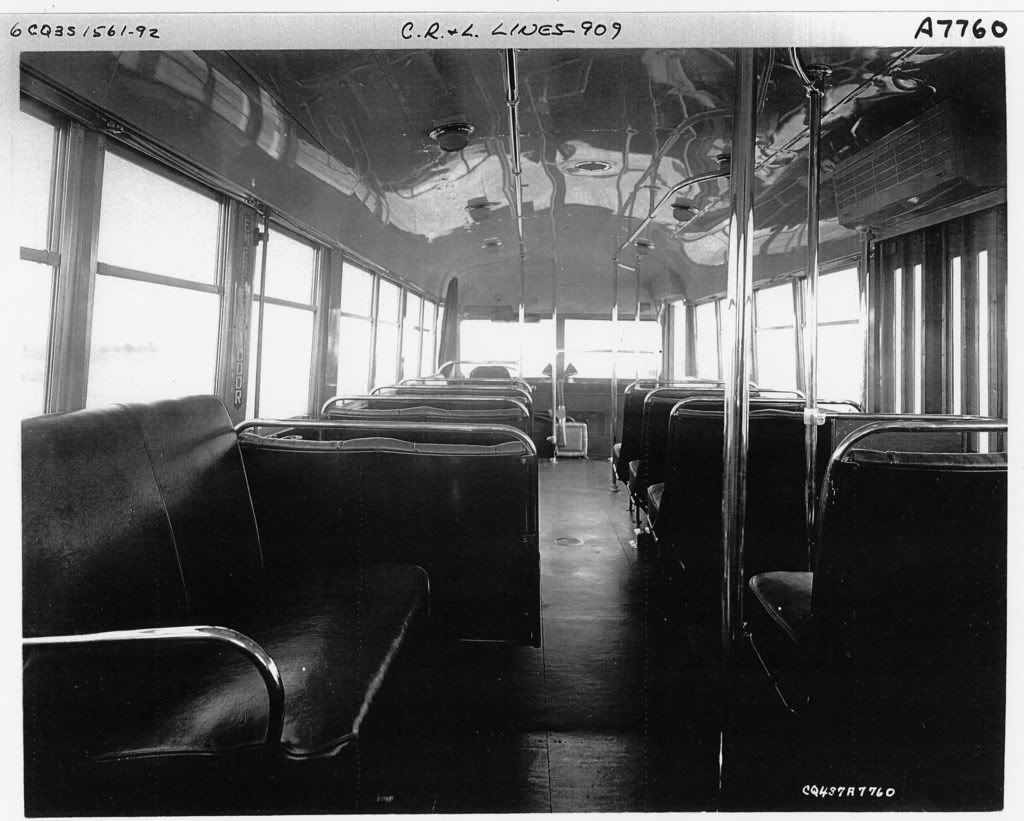 |
|
| Back to top |
|
 |
Bill D

Joined: 17 Apr 2007
Posts: 332
Location: Waterbury, CT
|
 Posted: Sat Nov 03, 2007 8:25 am Post subject: Posted: Sat Nov 03, 2007 8:25 am Post subject: |
 |
|
Here is CR&L #860, a 1936 built CQ, headed inbound to downtown Waterbury on the Walnut Street route. It then will continue across town to Highland Avenue. This was one of the first bus routes established in Waterbury, beginning operation November 12, 1921. The Walnut Street and Highland Avenue routes have been paired since the beginning, and continue to do so today, as CT Transit routes #20 and #40.
Bill

(Photo courtesy of John Sullivan and Alan Walker of the Connecticu Motor Coach Museum.) |
|
| Back to top |
|
 |
Mr. Linsky
BusTalk's Offical Welcoming Committee

Joined: 16 Apr 2007
Posts: 5071
Location: BRENTWOOD, CA. - WOODMERE, N.Y.
|
 Posted: Sat Nov 03, 2007 2:36 pm Post subject: Posted: Sat Nov 03, 2007 2:36 pm Post subject: |
 |
|
Bill D,
Another great photo to add to our CR&L file!
If you're a bit confused about the fact that my # 909 and your # 860 are both designated by Mack as being Model CQ's, here's the explanation;
Your # 860 was probably the last CQ of the old design (it also holds the distinction of being among the first rear engine Mack's ever produced).
In 1936 the CQ was completely redesigned except for the front end and it was turned into a baby version of the CT (which is what the 900's were).
Mack created a lot of confusion by not giving the updated CQ its own new designation - but Mack did strange things like that with, what I am sure, must have been good reasons!
Nevertheless, they were all great buses and certainly have a place at very near the top in the history of surface transportation - I love them!
I have attached a photo of a typical 'CT' from which you can easily discern the 'DNA' of the later CQ.
Photo courtesy of the Mack Truck Museum, Allentown, Pa.
Mr. Linsky - Green Bus Lines, Jamaica, NY
4758
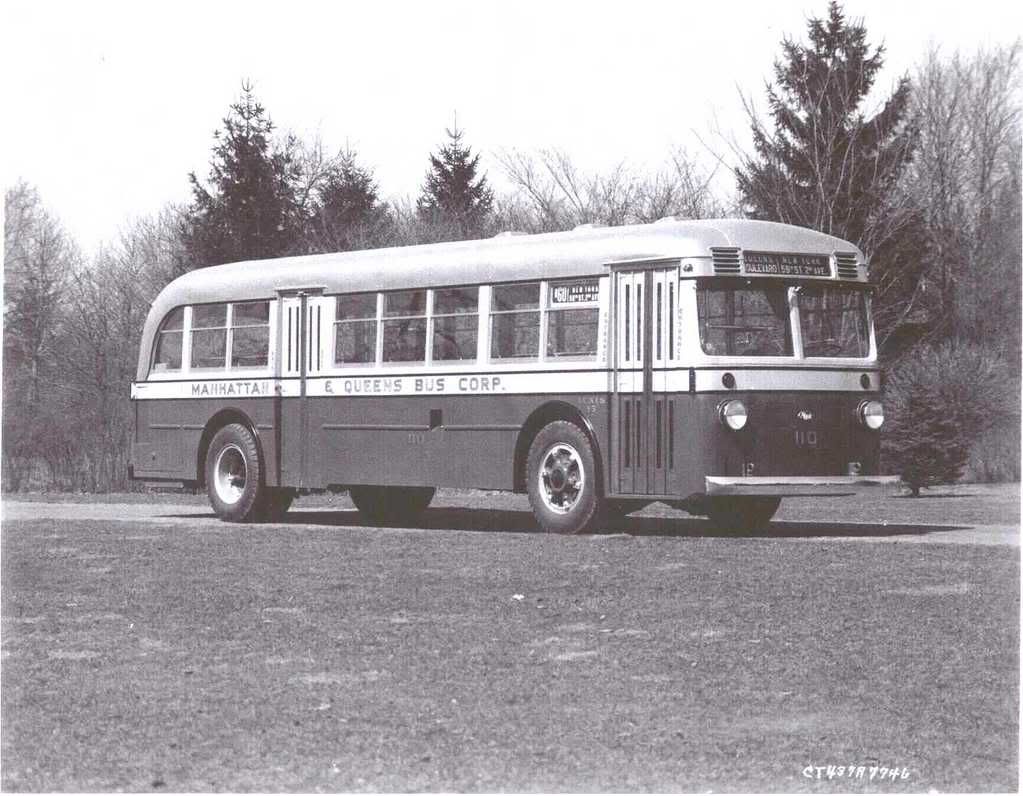 |
|
| Back to top |
|
 |
Mr. Linsky
BusTalk's Offical Welcoming Committee

Joined: 16 Apr 2007
Posts: 5071
Location: BRENTWOOD, CA. - WOODMERE, N.Y.
|
 Posted: Sun Nov 04, 2007 12:25 am Post subject: Posted: Sun Nov 04, 2007 12:25 am Post subject: |
 |
|
Pictured below is fleet # 8422 – a 1936 Yellow Parlor Coach and one of 18 (8416 to 8434 with serial #’s scattered between 033 and 051) purchased new by Public Service Coordinated Transport of New Jersey in that year.
The 31 passenger model 732 was revolutionary as it ushered in the era of rear engine design that consigned to history all traditional conventional models and remains as the accepted drive method even today.
This coach also paved the way to the modern GM Detroit Diesels with Hydraulic Transmissions that first appeared in the 1938 738 and 740 versions.
Unfortunately, the 700’s were short lived and were also consigned to history by 1940 to be replaced by what are now referred to as ‘Old Look’ transits and updated suburban coaches.
Unlike other buses that were specifically designed by Yellow for Public Service during the era, the 732’s were stock Yellow except, of course, for the custom PS logos under the windshields.
The company also bought transit versions of the same model in 1937 and 1939.
Also pictured below in a factory photo (lower) is one of two of the same model (differing only in the sedan entry door and the rear roof luggage rack) operating for Central Canadian Greyhound of Calgary, Alberta.
Upper photo; courtesy of the Motor Bus Society Collection.
Lower photo; unknown source and used for educational purposes only.
Mr. Linsky – Green Bus Lines, Jamaica, NY
4836

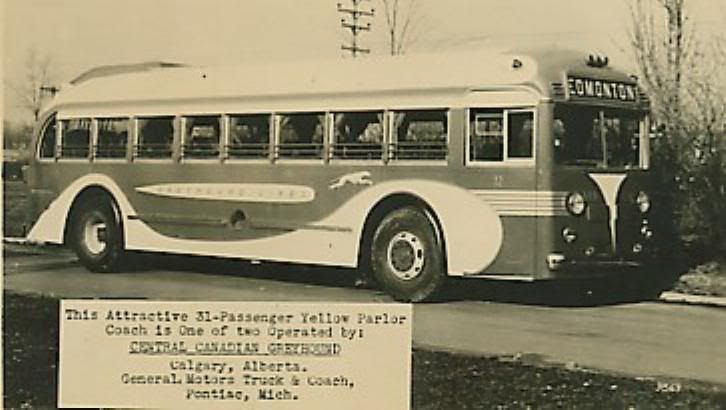 |
|
| Back to top |
|
 |
Bill D

Joined: 17 Apr 2007
Posts: 332
Location: Waterbury, CT
|
 Posted: Sun Nov 04, 2007 7:01 am Post subject: Posted: Sun Nov 04, 2007 7:01 am Post subject: |
 |
|
Mr. Linsky,
I enjoyed seeing the "Orange bus" ACF picture, as it reminded me of the buses I rode growing up. I was fortunate to live in an area served by the bus comany that I now work for, as they ran ACF H-17-S model buses well into the 1960's. The last one lasted until about 1970, and saw regular use on a tripper run. It was a favorite of the old timers that usually drove the bus. The picture below shows the last of the Northeast ACF's, #7, at the Waterbury Green. This is how I remember seeing the bus, and if I was downtown waiting to catch a bus home, I would deliberately miss the regular bus and wait for the tripper.

Photo courtesy of John Sullivan and Alan Walker of the Connecticut Motor Coach Museum.
When Northeast finally retired this bus, it was purchased by a couple of bus fans, who arranged to have it stored at the Connecticut Company garage in Hartford. They went on to form the Connecticut Motor Coach Museum, and this ACF (the last surviving H-17-S) is part of the collection.

The bus is being restored to its' original appearance as Springfield Street Railway #169. Springfield operated the bus from 1936 until about 1953, and Northeast operated it from then until 1970.
Bill |
|
| Back to top |
|
 |
Mr. Linsky
BusTalk's Offical Welcoming Committee

Joined: 16 Apr 2007
Posts: 5071
Location: BRENTWOOD, CA. - WOODMERE, N.Y.
|
 Posted: Sun Nov 04, 2007 5:05 pm Post subject: Posted: Sun Nov 04, 2007 5:05 pm Post subject: |
 |
|
The story of how the engine began to evolved from the front through the center and eventually to the rear of today’s modern buses.
With the first passenger bus in 1905 (a Mack Model #9 shown below) through the twenties and, in some cases, beyond that, buses of all types were constructed with wide separate bodies on narrow truck frames (also shown below) with the power plant forward of the driver.
This configuration was difficult to drive because of lack of good frontal vision and judgment, and became hazardous due to continuous leakage of fumes into the passenger cabin as well as excessive heat during the summer.
As early as 1927, Yellow Coach, a leader in innovation in the industry, had fabricated a prototype of a revolutionary design that moved the engine (or, in this case, the engines) to amidships under floor, and located the driver ahead of the front wheels with full unobstructed views of the roads and curbs ahead.
Yellow’s design included twin Cadillac 150 h.p. flat head V-8’s with direct drive shafts to the rear wheels.
While Yellow’s effort never saw production, Twin Coach (a specimen shown below), ACF and eventually Brill did see merit in the design and successfully marketed thousands of such buses.
ACF’s version, in particular, did suffer from constant fume leakages and even the special equipment designed to control the problem proved to be almost useless – but they never gave up and continued to produce amidships engines almost until the demise of the company in the late fifties.
Twin, on the other hand, dropped the design once they folded into Flxible in the forties.
Mack had never even dabbled with the idea preferring a cab over engine until 1935 when both they and Yellow introduced the transversely mounted rear engine which, of course, has been the standard ever since (see specimen below).
The advantages of moving the engine to the rear (see specimen below) were many fold; the shear weight of the power plant very nearly over the rear wheels gave the vehicle far greater control and traction in snow and ice conditions, virtually eliminated much of the noise in the passenger compartment and zeroed out any possibility of leakage of fumes.
Additionally, the elimination of the long drive shafts gave the ‘pusher’ models far greater power and economies.
It’s doubtful that there will ever be a next generation in engine location because they’re right where they should be now!
All photos have already been credited and have been borrowed for educational purposes only.
Mr. Linsky – Green Bus Lines, Jamaica, NY
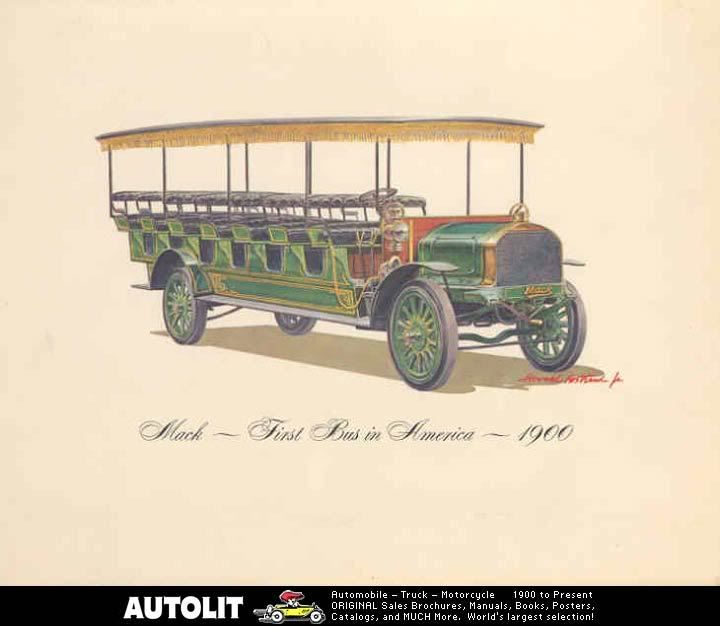
First Mack above (1905)
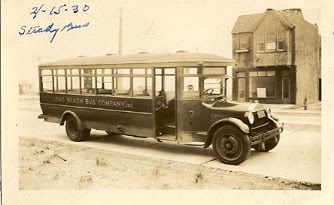
Typical Mack of the twenties above

First Twin amidships above (1933)

First Yellow rear engine above (1935)

Typical rear engine GM Old Look (1946) |
|
| Back to top |
|
 |
|
|
You cannot post new topics in this forum
You cannot reply to topics in this forum
You cannot edit your posts in this forum
You cannot delete your posts in this forum
You cannot vote in polls in this forum
You can attach files in this forum
You can download files in this forum
|
Powered by phpBB © 2001, 2005 phpBB Group
|
























